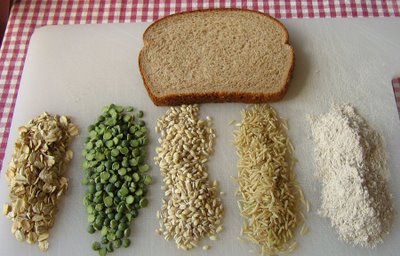
Leave answers in comments. If your answer is wrong but your justification worthy ... full credit. I'll be back with the dirt in a little bit.
Here's a little help:
From left to right, starting at the top with the bread:
- The bread is made with 100% whole wheat flour.
- The oats are rolled.
- The peas are split.
- The barley is pearled.
- The rice is brown.
- The flour is whole wheat.
The Dietary Guidelines for Americans, 2005, recommends that Americans consume 3 or more servings of whole grains per day, with a goal of at least half of their grains coming from whole grains.
But what's a "whole grain"?
The FDA is floating a draft document intended "to provide guidance to industry about what the agency considers to be "whole grain" and to assist manufacturers in labeling their products."
In general, a "whole grain" may be ground, cracked, flaked, or intact - but should consist of the grain's bran, germ, and starchy endosperm in the same proportions that they exist in the original grain.
Here are the answers:
- The bread is whole grain. Bread that is made entirely from whole grain flour may be labeled "whole grain".
- The oats are whole grain.
- The peas are not whole grain. Soybeans, lentils, beans, chickpeas, etc. are not grains but legumes.
- The barley is not whole grain. Pearling removes some of the bran which must be present as per the definition. Barley that is just dehulled, with the bran intact, is whole grain.
- The rice is whole grain.
- The flour is whole grain.
No comments:
Post a Comment